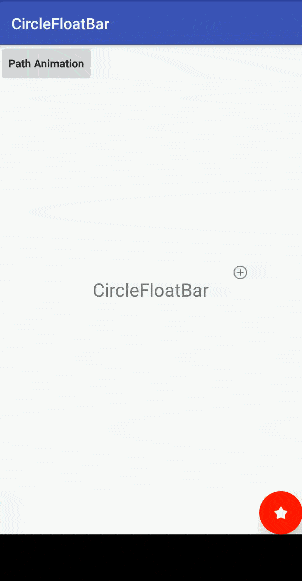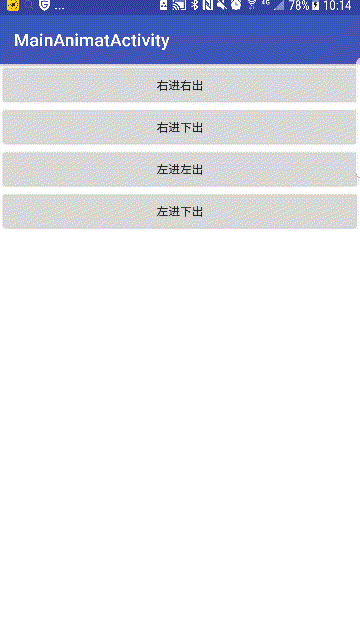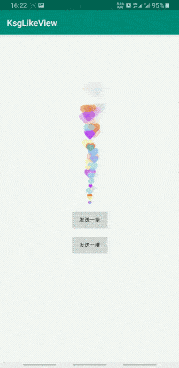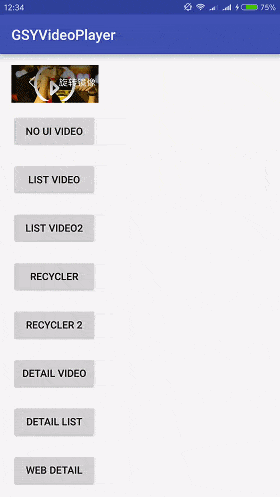视频播放是一个很常见的功能,根据功能需求的不同,有不同的实现方式。
如果只是类似预览的功能,可以直接调取系统的视频播放功能:
Intent intent = new Intent();
intent.setAction(Intent.ACTION_VIEW);
intent.setDataAndType(Uri.fromFile(new File(path)), "video/mp4");
activity.startActivity(intent);
这样做的话,就会跳出App,好处就是用起来简单,坏处就是离开的应用,如果有其他需求的话则无法实现。
最近的项目中用到的视频播放,有一些特殊的功能,比如不允许用户快进,但是可以退回,用户看过的部分可以快进。要记录播放进度,再次进入时要恢复进度。可以设置断点,断点暂停后用户需要手动点击继续播放。综上,上面的做法就不能用了,只能自己写一个播放器了。
之前用过Vitamio,整体的使用感觉还是比较顺利,文档示例都比较全。也没有什么大bug。但是商用收费!如果你对Vitamio感兴趣可以看这里。
这次就用了ijkplayer。ijkplayer的文档和示例都没有Vitamio那么多,我是在示例上修修改改的。它是可以支持的在线播放和本地播放的。
它们都是基于FFmpeg的,你也可以直接干FFmpeg。
按照ijkplayer的github一步步集成进来,还是比较顺利的。就是这样:
上面例子最好down下来,跑一下。
我用到了一个VideoView来播放视频,它是一个FrameLayout。
我是在这里扒的,这里代码还用到了其他的调用,一并copy过来,最后是这样的。
其他的代码你也可以在示例中找到。我把上面的代码放到了自己的项目中。
然后在布局中放入你写(拷)的IjkVideoView。
<?xml version="1.0" encoding="utf-8"?>
<LinearLayout xmlns:android="http://schemas.android.com/apk/res/android"
android:layout_width="match_parent"
android:layout_height="match_parent"
android:orientation="vertical"
android:background="@color/black">
<com.greendami.video.widget.media.IjkVideoView
android:id="@+id/video"
android:layout_width="match_parent"
android:layout_height="0dp"
android:layout_weight="1"></com.greendami.video.widget.media.IjkVideoView>
</LinearLayout>
如果你只是想简单的播放视频,对界面没有什么要求的话,可以使用ijkplayer提供的MediaController,直接就有进度条,暂停,播放等功能。
video.setMediaController(AndroidMediaController(this)),不需要的话就传个null进去就行。
只要这样就行:
package com.greendami.actvity.worknotes
import android.content.pm.ActivityInfo
import android.content.res.Configuration
import android.net.Uri
import android.os.Environment
import android.view.WindowManager
import android.widget.FrameLayout
import android.widget.LinearLayout
import com.allrun.dangjianshisanshi.R
import com.allrun.dangjianshisanshi.actvity.BaseActivity
import com.allrun.dangjianshisanshi.video.widget.media.AndroidMediaController
import com.allrun.dangjianshisanshi.widget.LoadingDialog
import kotlinx.android.synthetic.main.activity_worknote_videoplayer.*
import org.jetbrains.anko.toast
import tv.danmaku.ijk.media.player.IjkMediaPlayer
/**
* Created by greendami on 2017/8/30.
*/
class WorkNoteVideoPlayerActivity : BaseActivity() {
private val SIZE_DEFAULT = 0
private val SIZE_4_3 = 1
private val SIZE_16_9 = 2
private val currentSize = SIZE_DEFAULT
private var screenWidth = 0
private var screenHeight = 0
////http://www.modrails.com/videos/passenger_nginx.mov
var uri = Uri.parse(Environment.getExternalStorageDirectory().path + "/test.mp4")
var path = ""
override fun setContentView() {
setContentView(R.layout.activity_worknote_videoplayer)
}
override fun initView() {
IjkMediaPlayer.loadLibrariesOnce(null)
IjkMediaPlayer.native_profileBegin("libijkplayer.so")
LoadingDialog.showDialog(this)
initEvent()
}
private fun initEvent() {
back.setOnClickListener { finish() }
video.setOnCompletionListener {
toast("播放完毕")
finish()
}
video.setOnPreparedListener {
LoadingDialog.dismissDialog()
video.start()
setVideoLayoutSize()
}
}
private fun setVideoLayoutSize() {
initScreenInfo()
var width = video.width
var height = video.height
if (video.getmVideoWidth() / video.getmVideoHeight() > width / height) {
height = width * video.getmVideoHeight() / video.getmVideoWidth()
} else {
width = height * video.getmVideoWidth() / video.getmVideoHeight()
}
if (width > 0 && height > 0) {
val lp = video.getmRenderView().view.layoutParams as FrameLayout.LayoutParams
lp.width = width
lp.height = height
video.getmRenderView().view.layoutParams = lp
}
}
override fun bindData() {
video.setVideoPath(path)
video.setMediaController(AndroidMediaController(this))
}
override fun loadData() {
path = intent.extras["path"].toString()
}
private fun setScreenRate(newConfig: Configuration) {
var width = 0
var height = 0
if (newConfig.orientation === Configuration.ORIENTATION_LANDSCAPE) {//切换为横屏
when (currentSize) {
SIZE_DEFAULT -> {
width = video.getmVideoWidth()
height = video.getmVideoHeight()
}
SIZE_4_3 -> {
width = screenHeight / 3 * 4
height = screenHeight
}
SIZE_16_9 -> {
width = screenHeight / 9 * 16
height = screenHeight
}
}
} else { //竖屏
when (currentSize) {
SIZE_DEFAULT -> {
width = video.getmVideoWidth()
height = video.getmVideoHeight()
}
SIZE_4_3 -> {
width = screenWidth
height = screenWidth * 3 / 4
}
SIZE_16_9 -> {
width = screenWidth
height = screenWidth * 9 / 16
}
}
}
if (width > 0 && height > 0) {
val lp = video.getmRenderView().view.layoutParams as FrameLayout.LayoutParams
lp.width = width
lp.height = height
video.getmRenderView().view.layoutParams = lp
}
}
private fun fullChangeScreen() {
requestedOrientation = if (requestedOrientation == ActivityInfo.SCREEN_ORIENTATION_LANDSCAPE) {// 切换为竖屏
ActivityInfo.SCREEN_ORIENTATION_PORTRAIT
} else {
ActivityInfo.SCREEN_ORIENTATION_LANDSCAPE
}
}
override fun onConfigurationChanged(newConfig: Configuration) {
super.onConfigurationChanged(newConfig)
//重新获取屏幕宽高
initScreenInfo()
if (newConfig.orientation === Configuration.ORIENTATION_LANDSCAPE) {//切换为横屏
//去掉通知栏
//获得 WindowManager.LayoutParams 属性对象
val lp2 = window.attributes
//直接对它flags变量操作 LayoutParams.FLAG_FULLSCREEN 表示设置全屏
lp2.flags = lp2.flags or WindowManager.LayoutParams.FLAG_FULLSCREEN
//设置属性
window.attributes = lp2
//意思大致就是 允许窗口扩展到屏幕之外
window.addFlags(WindowManager.LayoutParams.FLAG_LAYOUT_NO_LIMITS)
val lp = video.layoutParams as LinearLayout.LayoutParams
lp.height = screenHeight
lp.width = screenWidth
video.layoutParams = lp
} else {
//恢复通知栏
//获得 WindowManager.LayoutParams 属性对象
val lp2 = window.attributes
//LayoutParams.FLAG_FULLSCREEN 强制屏幕状态条栏弹出
lp2.flags = lp2.flags and WindowManager.LayoutParams.FLAG_FULLSCREEN.inv()
//设置属性
window.attributes = lp2
//不允许窗口扩展到屏幕之外 clear掉了
window.clearFlags(WindowManager.LayoutParams.FLAG_LAYOUT_NO_LIMITS)
val lp = video.layoutParams as LinearLayout.LayoutParams
when (currentSize) {
SIZE_DEFAULT -> {
lp.height = video.getmVideoHeight() * screenWidth / video.getmVideoWidth()
}
SIZE_4_3 -> {
lp.height = screenWidth * 3 / 4
}
SIZE_16_9 -> {
lp.height = screenWidth * 9 / 16
}
}
lp.width = screenWidth
video.layoutParams = lp
}
setScreenRate(newConfig)
}
private fun initScreenInfo() {
val wm = this.windowManager
screenWidth = wm.defaultDisplay.width
screenHeight = wm.defaultDisplay.height
}
override fun onDestroy() {
video.release(true)
LoadingDialog.dismissDialog()
super.onDestroy()
}
}
如果不把BaseActivity放上来,可能看起来费劲,这个是我随便写的,请不要在意。
abstract class BaseActivity : LifecycleActivity() {
lateinit var modelHolder: ModelHolder
override fun onCreate(savedInstanceState: Bundle?) {
super.onCreate(savedInstanceState)
modelHolder = ViewModelProviders.of(this).get(ModelHolder::class.java)
setContentView()
loadData()
initView()
bindData()
}
abstract fun setContentView()
/**
* 请求数据
*/
abstract fun loadData()
abstract fun initView()
/**
* 把数据和控件绑定
*/
abstract fun bindData()
}
大体的步骤是:
//加载库文件
IjkMediaPlayer.loadLibrariesOnce(null)
IjkMediaPlayer.native_profileBegin("libijkplayer.so")
//设置文件路径可以是网络地址或者本地文件路径
video.setVideoPath(path)
//使用默认的控制界面,进度条快进等等
video.setMediaController(AndroidMediaController(this))
//绑定加载完成监听器,加载完了就播放
video.setOnPreparedListener {
LoadingDialog.dismissDialog()
video.start()
//这里是设置视频的尺寸,不是必须
setVideoLayoutSize()
}
//到此就完成了,如果你需要重力感应,全屏切换,请往下看
//如果按钮切换横竖屏,调用这个方法
fullChangeScreen()
//这里是横竖屏切换事件的回调
override fun onConfigurationChanged(newConfig: Configuration)
//这里是屏幕方向改变后重新计算视频尺寸,我是默认不改变视频长宽比的前提下铺满屏幕
//video.getmVideoWidth()是视频的尺寸,是我自己加的方法,只是返回了tmVideoWidth
//video.getmRenderView().view.layoutParams = lp这句是真正设置视频尺寸
private fun setScreenRate(newConfig: Configuration) {
initScreenInfo()
var width = screenWidth
var height = screenHeight
if (video.getmVideoWidth() / video.getmVideoHeight() > width / height) {
height = width * video.getmVideoHeight() / video.getmVideoWidth()
} else {
width = height * video.getmVideoWidth() / video.getmVideoHeight()
}
if (width > 0 && height > 0) {
val lp = video.getmRenderView().view.layoutParams as FrameLayout.LayoutParams
lp.width = width
lp.height = height
video.getmRenderView().view.layoutParams = lp
}
}
如果你需要控制视频,下面的API你可能会用到:
//进度控制
video.seekTo(progress)
//视频播放完毕回调
video.setOnCompletionListener {toast("播放完毕")}
//视频长度
video.duration
//暂停
video.pause()
//继续播放
if (!video.isPlaying) video.start()







